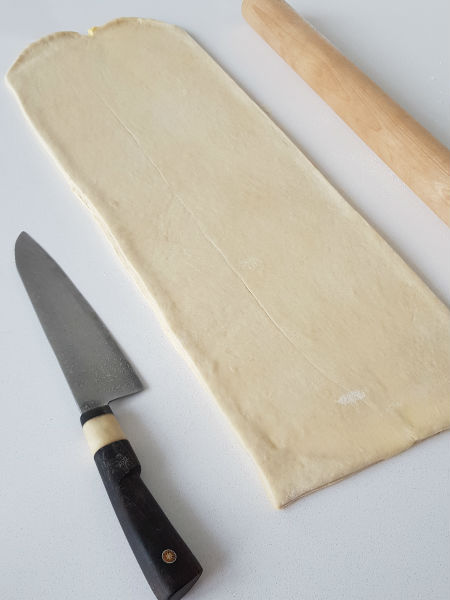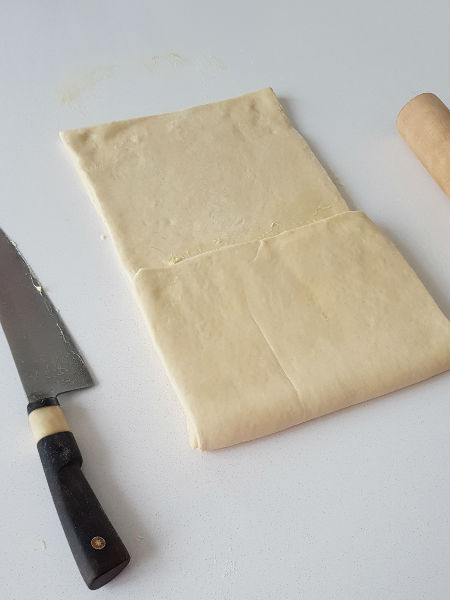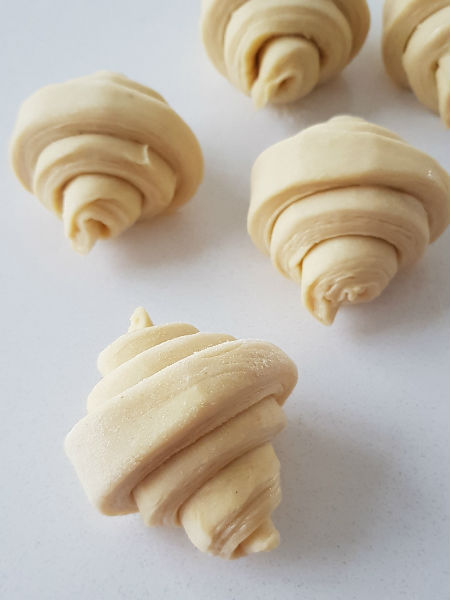

Sat, 14 July 2018

Croissants
ingredients:
500g strong white flour
10g salt
55g sugar
120g milk
100g water
20g yeast
40g softened butter
Additional 250g unsalted butter flattened out into a sheet – see instructions below
This recipe is a little more technical that a regular sweet dough. There are several steps involved but the effort is certainly worth it. To create a beautiful flaky buttery croissant, the dough must be laminated. Through a series of rolling and folding the dough layers of butter are created within the dough which when baked rise and puff apart. The dough should be made the night before so that it can be chilled overnight. Keeping the dough cold is essential to building the layers of butter within the dough.
This dough can be used to make a series of pasties including croissants, pain au chocolat, almond croissants and Danishes
Day 1:
1. Mix together the flour, salt and sugar in a bowl. Rub in the softened butter with your fingertips. The flour should resemble fine bread crumbs.
2. Combine the milk and the water. Crumble the yeast into the milk and water so that it dissolves (mix together using a fork) and pour the yeasted milk into the flour.
3. Bring the dough together with your hands or with a spatula. The dough will feel a little firmer than what you'd expect, but do not worry this is what we are looking for.
4. Turn the dough out on to a clean surface and knead for 4 to 5 minutes. The dough is purposely kneaded less than normal. The dough is under kneaded because the dough will be developed later through a series of rolling and folding.
5. Put the dough in an oiled bowl, cover with a damp tea towel or wrap with cling film and leave to prove in a fridge overnight.
6. Form the 250g block of unsalted butter into a sheet approximately ¾ cm in thickness. Form the butter into a sheet approximately 20cm x 15cm. Leave in the fridge until required.
Day 2:
1. Remove the dough and butter sheet from the fridge
2. On a clean work surface roll out the dough so that it is almost twice the size of the butter sheet. The dough should be approximately 15cm wide x 30cm long.

3. Place the butter sheet into the centre of the dough and fold the dough over from the top and bottom to encase the butter.
4. Turn the dough 90 degrees so that where the dough folds over the butter is on the left and right of the dough as you look at the dough.
5. Using a sharp knife, run the tip of knife down each side of the dough to make a small incision
6. Using a very light dusting of flour, roll out the dough until it has doubled in length. The dough should be rolled out gently and gradually. Do not apply too much down ward pressure as this will result in the layers of butter being squashed which can result in a bread like consistency to your croissant. The dough should be rolled out to approximately 15cm x 60cm.
7. Trim the outer edges of the dough sheet to remove any bits of dough which have not been encased with butter.
8. Brush off any excess flour from the surface of the dough. Fold the dough from the top about two thirds down.

9. Now fold the dough from the bottom on top of the dough that you have just folded so that one over lapses the other.

This is known as a half fold. Wrap the dough in cling film and place into the fridge for at least thirty minutes to chill.
10. After 30 minutes remove the dough from the fridge. Turn the dough 90 degrees so that the folds are on the left and right of the dough as you look at it.
11. Roll out the dough until it has doubled in length. Approximately 15cm x 60cm. Brush off any excess flour and repeat the book fold.
12. Wrap the dough in cling film and return the dough to the fridge for a further 30 minutes.
13. The dough is now ready to use. On a clean work surface roll out the dough until it is no more than a half cm in thickness. The dough should form a sheet approximately 20cm x 80 cm. The dough is now ready to be cut and shaped into varies pastries
14: To shape a croissant: Using a sharp knife or pizza cutter cut the dough into a series of triangles approximately 8 cm wide and 20cm in length.

15. Holding the dough at the base of the triangle stretch the dough slightly. Roll the dough up from the base of the triangle to the tip to form the croissant.

16. Place the rolled croissant onto a baking tray lined with parchment and allow to proof for 2 to 21/2 hours.
17. Preheat the oven to 190c. Brush each croissant generously with a beaten egg. Bake for 18 mins until golden all over. Place onto a wire rack to proof
18. This dough may also be used to shape pain au chocolat, almond croissants, and various danishes.